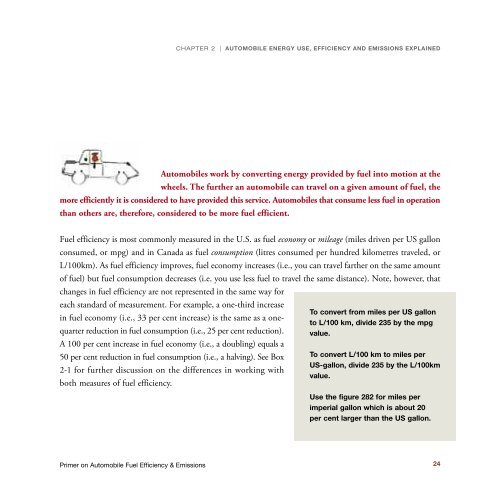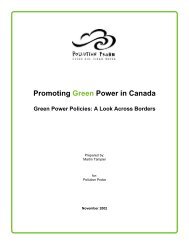Primer on Automobile Fuel Efficiency and Emissions - Pollution Probe
Primer on Automobile Fuel Efficiency and Emissions - Pollution Probe
Primer on Automobile Fuel Efficiency and Emissions - Pollution Probe
You also want an ePaper? Increase the reach of your titles
YUMPU automatically turns print PDFs into web optimized ePapers that Google loves.
CHAPTER 2 | AUTOMOBILE ENERGY USE, EFFICIENCY AND EMISSIONS EXPLAINED<br />
N<br />
<strong>Automobile</strong>s work by c<strong>on</strong>verting energy provided by fuel into moti<strong>on</strong> at the<br />
wheels. The further an automobile can travel <strong>on</strong> a given amount of fuel, the<br />
more efficiently it is c<strong>on</strong>sidered to have provided this service. <strong>Automobile</strong>s that c<strong>on</strong>sume less fuel in operati<strong>on</strong><br />
than others are, therefore, c<strong>on</strong>sidered to be more fuel efficient.<br />
<strong>Fuel</strong> efficiency is most comm<strong>on</strong>ly measured in the U.S. as fuel ec<strong>on</strong>omy or mileage (miles driven per US gall<strong>on</strong><br />
c<strong>on</strong>sumed, or mpg) <strong>and</strong> in Canada as fuel c<strong>on</strong>sumpti<strong>on</strong> (litres c<strong>on</strong>sumed per hundred kilometres traveled, or<br />
L/100km). As fuel efficiency improves, fuel ec<strong>on</strong>omy increases (i.e., you can travel farther <strong>on</strong> the same amount<br />
of fuel) but fuel c<strong>on</strong>sumpti<strong>on</strong> decreases (i.e. you use less fuel to travel the same distance). Note, however, that<br />
changes in fuel efficiency are not represented in the same way for<br />
each st<strong>and</strong>ard of measurement. For example, a <strong>on</strong>e-third increase<br />
in fuel ec<strong>on</strong>omy (i.e., 33 per cent increase) is the same as a <strong>on</strong>equarter<br />
reducti<strong>on</strong> in fuel c<strong>on</strong>sumpti<strong>on</strong> (i.e., 25 per cent reducti<strong>on</strong>).<br />
A 100 per cent increase in fuel ec<strong>on</strong>omy (i.e., a doubling) equals a<br />
50 per cent reducti<strong>on</strong> in fuel c<strong>on</strong>sumpti<strong>on</strong> (i.e., a halving). See Box<br />
2-1 for further discussi<strong>on</strong> <strong>on</strong> the differences in working with<br />
both measures of fuel efficiency.<br />
To c<strong>on</strong>vert from miles per US gall<strong>on</strong><br />
to L/100 km, divide 235 by the mpg<br />
value.<br />
To c<strong>on</strong>vert L/100 km to miles per<br />
US-gall<strong>on</strong>, divide 235 by the L/100km<br />
value.<br />
Use the figure 282 for miles per<br />
imperial gall<strong>on</strong> which is about 20<br />
per cent larger than the US gall<strong>on</strong>.<br />
<str<strong>on</strong>g>Primer</str<strong>on</strong>g> <strong>on</strong> <strong>Automobile</strong> <strong>Fuel</strong> <strong>Efficiency</strong> & Emissi<strong>on</strong>s<br />
24
















